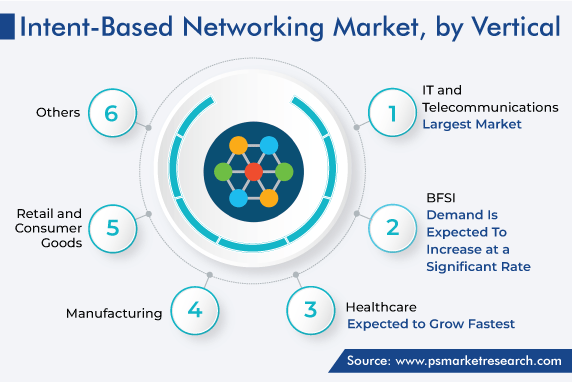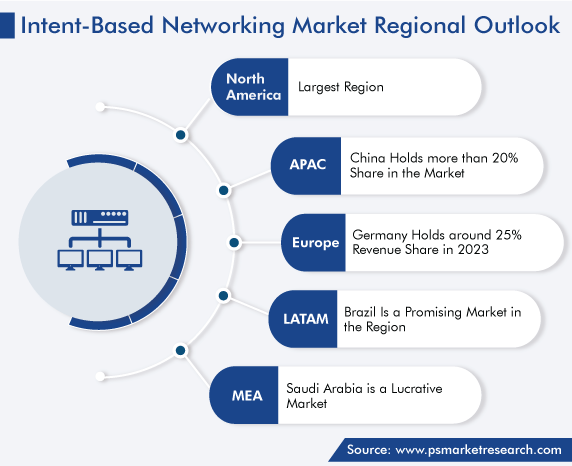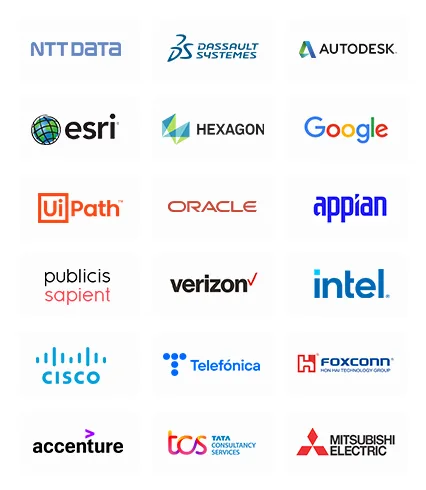Market Statistics
| Study Period | 2019 - 2030 |
| 2024 Market Size | USD 1,425.3 Million |
| 2030 Forecast | USD 5,606.3 Million |
| Growth Rate(CAGR) | 25.6% |
| Largest Region | North America |
| Fastest Growing Region | Asia-Pacific |
| Nature of the Market | Fragmented |
Report Code: 12690
Get a Comprehensive Overview of the Intent-Based Networking Market Report Prepared by P&S Intelligence, Segmented by Component (Solutions, Services), Deployment Type (On-Premises, Cloud), Organization Size (Large Enterprises, SMEs), Vertical (IT and Telecommunications, BFSI, Manufacturing, Healthcare, Retail and Consumer Goods), and Geographic Regions. This Report Provides Insights from 2019 to 2030.
| Study Period | 2019 - 2030 |
| 2024 Market Size | USD 1,425.3 Million |
| 2030 Forecast | USD 5,606.3 Million |
| Growth Rate(CAGR) | 25.6% |
| Largest Region | North America |
| Fastest Growing Region | Asia-Pacific |
| Nature of the Market | Fragmented |

Explore the market potential with our data-driven report
The global intent-based networking market size was USD 1,425.3 million in 2024, which is expected to reach USD 5,606.3 million by 2030, growing at a CAGR of 25.6% during 2024–2030.
This is owing to the fact that the networking industry is shifting from conventional networks to intent-based ones due to their advanced features. This is being done to reach maximum output and efficiency with the help of the fewest possible resources.
IBN helps in providing greater network visibility and control, enhances scalability, streamlines network operations through automation, and supports cloud and hybrid environments, ultimately strengthening security and compliance measures. Further, it allows companies to function well amidst the increasing network complexity and supports digital transformation objectives. These features influence IBN’s adoption among enterprises as they look for effective, flexible, and scalable networking solutions to achieve their digital goals. IBN can help corporate network configurations achieve 99.9% efficiency.
Moreover, it is seen as a practical approach to networking, in which coding and specific APIs help in structuring, organizing, and planning particular modifications to the current system, in order to enhance accessibility and agility.
Additionally, the IT infrastructure can be modified using IBN, in line with network administrators’ service requests, depending on the corporate objective. It incessantly generates crucial network insights and automatically modifies the hardware configuration to achieve goals. This leads to networking becoming business-centric, instead of device-centric. To enhance IT networks’ adaptability in every way, IBN integrates IT automation with analytics from machine learning and artificial intelligence.
Presently, almost all networks are controlled manually by system administrators, who give access to users and create scripts that highlight every step needed to carry out a specific activity, through a command line interface (CLI). Whereas, with intent-based networking, many devices automatically understand their responsibilities and corporate intent, without the interference of engineers to individually modify each one.
SDN, which stands for software-defined networking, automates setups to enhance scalability and dependability, while delivering greater flexibility for altering the networks and an overall view of network topology. A solution built on the same principles of untying the network forwarding and control function, known as , is being widely implemented owing to its features that can be compared to those of SDN. However, now, intent-based networking is replacing even SD-WAN in current scenarios, due to the increasing popularity of virtualization.
Owing to the enhanced agility, higher efficiency, simpler communication, and better decision making, digitalization has resulted in a considerable surge in the use of intent-based networking across all verticals.
Consumers of Google Cloud, including Spotify, Snapchat, and Instagram, have faced problems and experienced losses in the past, which Google was tasked to rectify. This is also becoming a primary factor in the market’s growth, as every corporate entity wants reduced downtimes.
Under the component segment, in 2023, the industry was dominated by the solutions category, with a revenue share of more than 65%, globally.
IBN solutions are crucial for lowering the complexity of networks, as they allow organizations to utilize the graphical user interface (GUI) in order to enhance and automate the network configuration process. The necessity to reevaluate business models by using cutting-edge algorithms, GUIs, and network transparency, in order to enhance network efficiency, is driving the focus of firms on IBN automation, with the surging need to provide a new and highly personalized client experience.
Managed services will achieve the higher growth rate due to the lack of skilled IT professionals, surge in the demand for secure IT infrastructure, need for cost and risk reduction, and necessity for regulatory compliance and security.
IT support is provided as part of managed services in order to enhance client experiences. Businesses give contracts to managed service providers to keep their IT infrastructure in check and ensure other operational requirements are met. Organizations find it tiring to handle these tasks simultaneously with their core business operations. As a result, they rely to a great extent on external partners for availing of managed services.
Based on deployment type, the on-premises category is expected to dominate the market during the estimation time frame, with a share of 75% in 2030, due to the ease of deployment of these solutions.
This domination is also due to the ongoing digitalization in almost every industry. Businesses that are still using outdated methods to manage their networks are finding it hard to compete with forward-thinking rivals. This has encouraged and strengthened the security requirements for networking components, which are better managed and operated with software and servers deployed onsite.
The larger contribution to the market revenue by large enterprises is due to their enormous investments in intent-based networking and related services to proficiently manage their consumer base. One more factor behind their significant revenue contribution is their higher financial capacity, owing to which they can purchase expensive infrastructure to deploy IBN.
Moreover, the widespread use of smartphones and laptops in large corporations has added to the market growth. To manage and integrate connected devices, multinational organizations utilize IBN solutions and services.
The growth of the BFSI category will be owing to the surge in the implementation of cutting-edge IBN solutions in order to speed up the rollout of digital services and customer-centric business models by financial institutions.
Banks are investing in these services to augment their working efficiency and enhance individuals’ banking experiences. The increasing popularity of UPI platforms around the world leads to complexities in transaction processing, which ultimately creates the requirement for advanced networks, thus adding to the demand for IBN.
Further, security is of topmost importance for banks due to the sensitive nature of financial and customer data. IBN helps implement security policies continuously across the network infrastructure, find out policy violations, enhance access controls, and automatically respond to security threats.
Additionally, the BFSI sector needs networks that can quickly evolve according to the shifting business needs. IBN has the capacity to automate network changes, to cater to the real-time demands of clients. For instance, if a bank is facing a sudden surge in the volume of customer transactions, this technology can dynamically assign network resources to meet the increase in the demand.
Intent-based networking helps the BFSI sector in providing cutting-edge services to all branch locations by increasing its reach to a variety of consumers and business prospects.

Drive strategic growth with comprehensive market analysis
North America’s domination on the market is a result of the presence of prominent companies, such as A10 Networks Inc., Cerium Networks, Astra Inc., Cisco Systems Inc., and Forward Networks Inc. Essentially, the region’s advanced technology and enormous telecom infrastructure are propelling the demand for IBN. Futuristic innovations and the wide access to enhanced network architecture are further leading to the market growth.
Moreover, technological advancements have been possible due to the surge in internet usage. Governments and businesses in the region have constantly invested in research and developments, taking the region’s technological capacity to the next level. For example, according to the Artificial Intelligence Index Report published by Stanford University, between 2018 and 2022, North America reported more than 60% of the global AI patent citation activity.
Further, the surging number of government initiatives in emerging economies for the upgradation of small and medium enterprises is propelling the Asia-Pacific market. One of the government initiatives in this respect is Make in India, which focuses on boosting production and the use of advanced technologies in multiple industries. The SDN and NFV technologies are being used in many industries to enhance operational efficiency.

Based on Component
Based on Deployment Type
Based on Organization Size
Based on Vertical
Geographical Analysis
Want a report tailored exactly to your business need?
Request CustomizationLeading companies across industries trust us to deliver data-driven insights and innovative solutions for their most critical decisions. From data-driven strategies to actionable insights, we empower the decision-makers who shape industries and define the future. From Fortune 500 companies to innovative startups, we are proud to partner with organisations that drive progress in their industries.


Working with P&S Intelligence and their team was an absolute pleasure – their awareness of timelines and commitment to value greatly contributed to our project's success. Eagerly anticipating future collaborations.
McKinsey & Company
IndiaOur insights into the minutest levels of the markets, including the latest trends and competitive landscape, give you all the answers you need to take your business to new heights
We take a cautious approach to protecting your personal and confidential information. Trust is the strongest bond that connects us and our clients, and trust we build by complying with all international and domestic data protection and privacy laws
Customize the Report to Align with Your Business Objectives
Request the Free Sample Pages